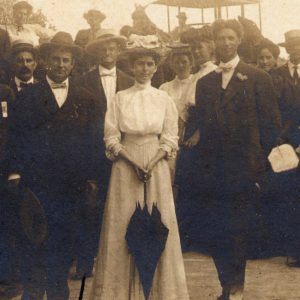calsfoundation@cals.org
Fred Wallace Bartell (1872–1958)
Frederick Wallace Bartell was a Siloam Springs (Benton County) merchant, church leader, and Circuit Chautauqua manager. He organized Associated Chautauquas, which was among the first “tent” or “traveling” Chautauqua circuits.
Fred W. Bartell was born in Milford, Kansas, on October 12, 1872, to immigrant parents. His father, Edward Charles Bartell, was from Germany; his mother, Louesa (or Louise), Edward’s second wife, was from France. He was the fourth of their five children. There also were six children from Edward’s first marriage to Catharine Branscom, who died in 1860. Louesa died in 1878.
Edward Bartell and other family members migrated to Siloam Springs sometime before May 1892, when Fred Bartell arrived. Bartell said of his arrival, “I came with the flood,” referring to the Sager Creek flood that devastated the downtown district of Siloam Springs. He traveled by train to the Sulphur Springs (Benton County) rail terminal in the northern part of the county, where he waited a week for flood waters to recede before proceeding on to Siloam Springs, nestled in the southwestern corner of the county. In July 1892, Bartell and his father opened a dry goods store, the Right Place. The business soon became successful and remained so even after Bartell’s father’s death in 1895.
On June 9, 1897, Bartell married Harriet Elizabeth “Daisy” Denny. They had four children, including a daughter who died in infancy.
The extended Bartell and Denny families provided leadership for numerous church and civic endeavors in Siloam Springs. The Dennys were lay leaders of the Methodist Episcopal Church that was co-founded by Daisy’s grandfather in 1880; they also were involved in the conception of Arkansas Conference College in 1899. Daisy Bartell was a charter member of the Woman’s Fortnightly Club, a local civic organization founded in 1901. Fred Bartell served terms as district president of the Epworth League, a Methodist Episcopal youth organization, circa 1902–1903.
Bartell’s church and commercial interests converged with his involvement in the Chautauqua movement, first with the Arkansas Chautauqua Assembly and, later, with his Associated Chautauquas. The movement began as a summer training retreat for Methodist Episcopal Sunday School teachers established in 1874 at Chautauqua Lake, New York. The retreat rapidly transcended its sectarian and geographic boundaries, broadening the scope of on-site programs and, through the Chautauqua Literary and Scientific Circle, distributing literary classics to hundreds of affiliated reading circles, including one in Siloam Springs.
The “Mother Chautauqua” inspired some 200 imitators. The Arkansas Chautauqua Assembly opened at Siloam Springs in 1885. Before long, the name “Chautauqua” became synonymous with public assemblies providing edification, education, and entertainment, typically situated in rural resort settings.
The movement’s “tent” or “traveling” era originated with efforts to rationalize Chautauqua logistics, such as packaging programs and selling them to communities organized into circuits to achieve greater transportation efficiency. Circuits extended Chautauqua’s reach to millions of residents of rural communities throughout North America. Keith Vawter, who organized a circuit in 1904, is usually credited as Circuit Chautauqua’s founder, but other pioneers, notably J. Roy Ellison and Charles Horner, deserve credit, too. Five circuit “inventors” are listed in the April 1920 issue of Lyceum Magazine, among them Vawter and Bartell. Chautauqua lecturer Hugh Orchard ranked Bartell “as one of the real pioneers in circuit chautauqua.”
Bartell produced his first Chautauqua in Siloam Springs in 1904 and founded Associated Chautauquas in 1905, booking five communities in Arkansas, Kansas, and Oklahoma. In 1906, he expanded into Missouri. While not approximating the massive scale of better-known circuits, such as Redpath, Bartell’s circuit did achieve moderate success, eventually including twenty-four towns. He employed many of the biggest Chautauqua “stars” of the era, including lecturers such as Governor Charles H. Brough, William Jennings Bryan, and Senator Robert M. La Follette of Wisconsin.
In 1910, the Bank of Siloam, which held Bartell’s circuit’s deposits, failed. Bartell was forced into bankruptcy. His infant daughter died in the same year. Financial difficulties and legal entanglements ensuing from the bank’s failure ended his circuit.
In 1918, Bartell sold the Right Place store and relocated his family to Wichita Falls, Texas, where they remained for several years. From there, he went with his wife and daughter to California, where they resided until 1925, when they moved to Seattle, Washington. His cousin, George H. Bartell Sr., had founded Bartell Drugs, which has become the nation’s oldest family-owned drugstore chain, there in 1890. What role, if any, kinship may have played in Bartell’s decision to move to Seattle is unknown. It also is not known if he was employed by, or otherwise financially involved with, Bartell Drugs. However, it is known that he earned income by renting apartments he owned in Seattle’s University District. In 1926, the Bartells and their daughter joined University Temple Methodist Church.
Daisy Bartell died on December 25, 1951. On January 2, 1954, Bartell married Pansy Duskin, a former employee of the Right Place. She shared Daisy’s civic mindedness, and the Bartells, especially Pansy, were esteemed lay leaders with University Temple Methodist Church.
Bartell died in Seattle on November 22, 1958. He is interred in Oak Hill Cemetery in Siloam Springs alongside his first wife.
For additional information:
Bartell, Fred W. “An Account of the Flood of 1892—Siloam Springs, Arkansas.” T. L. & M. Genealogy 7.4 (1999): 94.
Bartell, Fred W. “The Chautauquas: The Associated Chautauquas.” The Lyceumite & Talent (August 1907): 37–38.
Orchard, Hugh A. Fifty Years of Chautauqua: Its Beginning, Its Development, Its Message, Its Life. Cedar Rapids, IA: Torch Press, 1923.
Siloam Springs Museum. Siloam Springs, Arkansas. http://www.siloamspringsmuseum.com/ (accessed February 5, 2024).
Smith, Maggie A. Hico, A Heritage: Siloam Springs History. Vol. 1. Cassville, MO: Willard Burton, 1976.
Greg A. Phelps
Lindsey Wilson College
 Early Twentieth Century, 1901 through 1940
Early Twentieth Century, 1901 through 1940 Bartell House
Bartell House  Fred Bartell
Fred Bartell  Chautauqua Building
Chautauqua Building 




Comments
No comments on this entry yet.